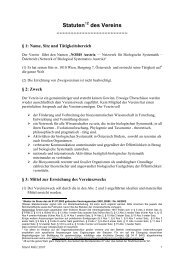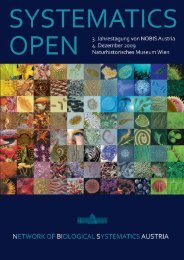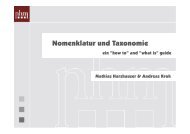4. Jahrestagung von NOBIS Austria 2. - 3. Dezember 2010
4. Jahrestagung von NOBIS Austria 2. - 3. Dezember 2010
4. Jahrestagung von NOBIS Austria 2. - 3. Dezember 2010
Create successful ePaper yourself
Turn your PDF publications into a flip-book with our unique Google optimized e-Paper software.
The roots of sea-turtle fouling barnacles (Chelonibiidae,<br />
Cirripedia, Balanomorpha)<br />
Harzhauser, M. 1 , Newman, W.A. 2 & Grunert, P. 3<br />
1 Natural History Museum Vienna, Geological-Paleontological Department, Burgring 7, A-1014 Vienna,<br />
<strong>Austria</strong>, e-mail: mathias.harzhauser@nhm-wien.ac.at<br />
2 Scripps Institution of Oceanography, California, USA. E-mail: wnewman@ucsd.edu<br />
3 Institute for Earth Sciences, University of Graz, Heinrichstraße 26, A-8010 Graz, <strong>Austria</strong>. E-mail:<br />
patrick.grunert@uni-graz.at<br />
The geological evidence for the phylogeny of sessile barnacles comes predominately from intertidal<br />
and shallow sublittoral records. Therefore, numerous balanoid species of genera such as Acasta,<br />
Concavus, Perforatus and Balanus are described. This wealth in data is contrasted by an extremely<br />
poor knowledge of open marine taxa which obligatorily cling to free swimming objects such as gars,<br />
cetaceans, sirenians, turtles and even sea snakes . This group is mainly represented by members of<br />
the coronuloid barnacles (chelonibiids, platylepadids & coronulids). The origin of the mainly sea-turtle<br />
fouling balanomorph family Chelonibiidae is still poorly documented. Aside from an erratic Eocene<br />
occurrence, assigned to an extinct subfamily, the extant subfamily Chelonobiinae did not appear in the<br />
fossil record before the Late Miocene. Now, a new lineage is recorded as an extinct sister-group of the<br />
Chelonibiinae. It is based on a 21-million-year-old fossil colony from Pucking (Ebelsberg Formation;<br />
Upper <strong>Austria</strong>). The new subfamily is known so far only from the proto-Mediterranean and the<br />
Paratethys seas and ranged from Early Miocene to Late Pliocene times. Members of the subfamily are<br />
characterised by large walls with tripartite rostra which display distinct sutures on the external surface.<br />
The tripartite rostrum, however, has evolved independently several times in the evolution of the<br />
balanomorphs and cannot be treated as synapomorphy. The subfamily comprises one new genus and<br />
two species.<br />
The sculpture of the host substratum is preserved as imprints along the carino laterals of one<br />
specimen. Although the pattern of ridges and furrows cannot be identified with certainty, the<br />
similarities with the sculpture of the carapax of modern Caretta suggests the new genus as earliest<br />
record of sea-turtle fouling in balanids. The co-existence of members of both subfamilies during the<br />
Miocene and Pliocene documents a higher diversity of chelonibiids in pre-Pleistocene times and<br />
indicates that Chelonibiinae were able to outcompete their supposed sister-group with the onset of the<br />
glacial cycles.<br />
_____________________________________________________________________________<br />
Ber. Inst. Erdwiss. K.-F.-Univ. Graz, Band 15, <strong>2010</strong>; ISSN 1608-8166 19






